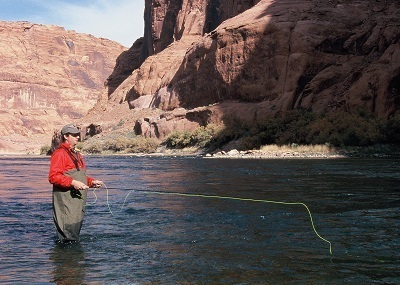From Sportfishing
Fish Report for 10-1-2022

Agencies monitoring conditions that threaten trout below Glen Canyon Dam
10-1-2022
Arizona Game & Fish Department
LEES FERRY, Ariz. – Lower water levels at Lake Powell and rising temperatures in the Colorado River are contributing to dangerously low dissolved oxygen levels below Glen Canyon Dam, causing concern for the health of the trout fishery located near Lees Ferry.
The Arizona Game and Fish Department is working with the Bureau of Reclamation (BOR), the U.S. Geological Survey, and other partners and stakeholders to closely monitor water quality conditions and better understand potential effects.
Fish native to the Colorado River, such as humpback chub and razorback sucker, are generally located farther downstream where low dissolved oxygen levels are remedied by riffles and runs, which aerate the water. The poor water quality just below the dam is adversely impacting only the rainbow trout population located in that area.
The Bureau of Reclamation’s water quality forecasts suggested there was potential for reaching low dissolved oxygen levels below the dam this year, but it wasn’t anticipated to happen until early autumn, according to a Sept. 1 news release from BOR.
Reduced oxygen in the water causes stress, increases metabolic rates, and ultimately can result in fish kills or fish moving downstream to seek refuge in cooler, more oxygen-rich river habitats. The partner agencies are continuing to closely monitor temperature, dissolved oxygen levels and fish health in the area.
This is not the only fish-related challenge facing this stretch of the Colorado River. Earlier this summer, juvenile smallmouth bass, a predatory, non-native fish, were found in a slough connected to the river approximately two miles below the dam. The National Park Service treated the slough with rotenone and installed a fabric barrier to keep the smallmouth bass from leaving the slough and entering the river. If the bass establish themselves far downstream, they can be threats to native fish.
Over the last two decades, the partner agencies have engaged on various drought response operations. However, given that water levels continue to decline, additional action is needed. In August, the 2023 Colorado River water operations were announced by the Department of the Interior, including reduced releases from Lake Powell and additional shortage declarations downriver for Lake Mead, demonstrating the severity of the drought and critically low reservoirs.
Jim Strogen wrote a good article in the Payson Roundup in early September describing the situation at Lake Powell and Lees Ferry. Read the article.
< Previous Report Next Report >
More Reports
Arizona Game & Fish Department Reports
for Saturday, October 1st, 2022Kaibab Lake: Kaibab Lake Fishing Report
Cataract Lake: Access to the lake is open
City Reservoir: Recent rains have filled the lake
Dogtown Lake: The lake is full and the water clarity is good
Santa Fe Lake: Santa Fe Lake Fishing Report
Ashurst Lake: Water clarity is good
Francis Short Pond: The pond suffered a fish kill due to low dissolved oxygen
Kinnikinick Lake: The lake level is down, but there are no issues launching a boat
Lake Pleasant: Getting reports of some decent bass fishing
Roosevelt Lake: Roosevelt Lake Fishing Report
Bartlett Lake: Bartlett Lake Fishing Report
Oak Creek: Oak Creek Fishing Report
West Clear Creek: West Clear Creek Fishing Report
Woods Canyon Lake: Woods Canyon Lake Fishing Report
Blue Ridge Reservoir: Blue Ridge Reservoir Fishign Report
Knoll Lake: Knoll Lake Fishing Report
Huffer Tank: Water Level is Low
Big Lake: Big Lake Fishing Report
Alamo Lake: Alamo Lake Fishing Report
Lake Havasu: Lake Havasu Fishing Report
Colorado River - Lees Ferry: Lees Ferry Report
Parker Canyon Lake: Parker Canyon Lake Fishing Report

9-13-2022
PHOENIX — Arizona’s dove hunters still have time to get out in the field before the 15-day season ends at legal...... Read More

Website Hosting and Design provided by TECK.net